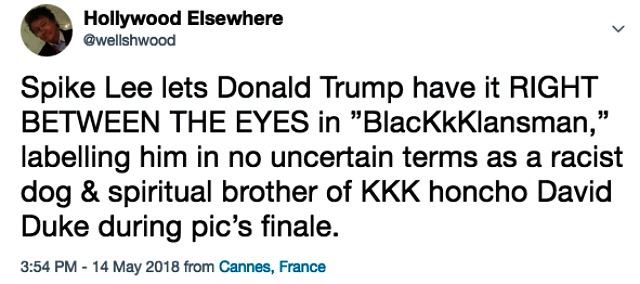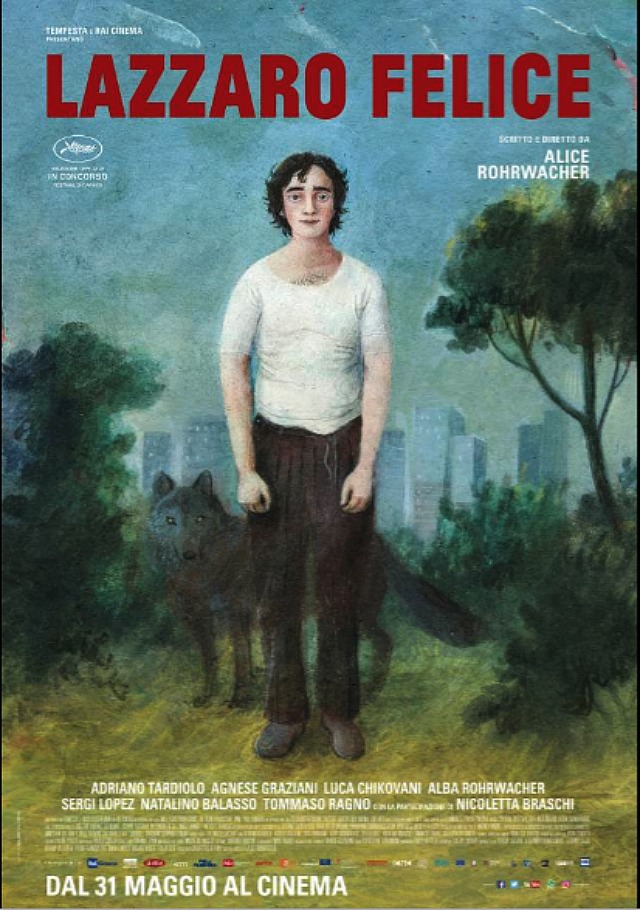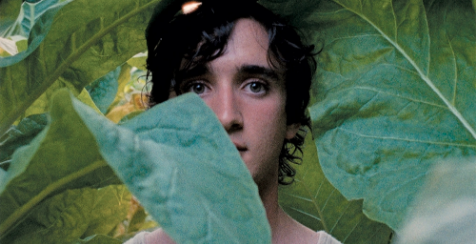Missing this wasn’t my intention. I tried like hell. Schedule another screening between now and next Friday and I’m there.
Day: May 14, 2018
Old Guy vs. Hipster Tuxedo Pants
Prior to last night’s screening of Chris Nolan’s “unrestored” 2001: A Space Odyssey, Nolan was joined on the stage of the Salle Debussy by costar Keir Dullea, longtime Kubrick producer Jan Harlan and Cannes Film Festival topper Thierry Fremaux. The below photo is of (l. to r.) the tuxedo pants of Dullea, Harlan, Katharina Kubrick and finally Fremaux’s. Notice how Fremaux’s slimly tailored tuxedo pants are the only ones that look hip, and how Dullea and Harlan’s are baggy and blowsy with the cuffs bunched at the cuff — the way tuxedo pants were styled 20 years ago and before. I myself wouldn’t be caught dead in tuxedo pants that look like Dullea’s and Harlan’s, but that’s me. Some people don’t care about this stuff, but you have to care.

Lee’s “Klansman” Busts Trump Like A Bitch
Spike Lee‘s BlacKkKlansman (Focus Features, 8.19) isn’t a great film, but it’s his strongest since Inside Man (’06) and before that The 25th Hour (’01), and easily his most impassioned, hard-hitting film about the racial state of things in the U.S. of A. since Malcom X (’92).
You can feel the fire and rage in Lee’s veins in more than a few scenes, and especially during the last five minutes when Lee recalls the venality of 2017’s “Unite the Right” really in Charlottesville, which ended with the death of protestor Heather Meyer, and reminds that Donald Trump showed who and what he is with his non-judgmental assessment of the KKK-minded demonstrators. Lee paints Trump with the racist brush that he completely deserves, and it makes for a seriously pumped-up finale.

But that doesn’t change the fact that BlacKkKlansman is basically a police undercover caper film, based on Ron Stallworth’s 2014 novel (“Black Klansman: Race, Hate, and the Undercover Investigation of a Lifetime”).
Nor the fact that tonally it sometimes feels like Starsky and Hutch or even to some extent like John Badham‘s Stakeout, especially as it involves the main cop protagonist falling in love with a girl (in this case an Afro’ed black activist played by Laura Harrier) who shouldn’t know what he’s up to, but whom he eventually confesses to. In this sense John David Washington‘s Stallworth is Richard Dreyfuss in the Badham film, and Adam Driver (as partner Flip Zimmerman) is Emilio Estevez.
At times the film also reminds you of some Clarence Williams III scenes from The Mod Squad.
Set in 1972, pic isn’t literally about Stallworth joining the Ku Klux Klan but a stealthy undercover investigation of the Klan, initiated when he was the first black detective in the history of the Colorado Springs Police Department.
After initial correspondence with the Klan, Stallworth received a call in which he was asked if he wants to “join our cause.” Stallworth answered affirmatively, and in so doing launched an audacious, fraught-with-peril inquiry.
SPOILER-ISH BUT NOT REALLY: Right away you’re telling yourself, “Yes, I know this actually happened and that Lee is using the facts in Stallworth’s book, but it made no sense for Fallworth to be heavily involved in this operation.” And it just feels crazy as you’re watching one crazy incident after another.
Holy Innocent
Alice Rohrwacher‘s Happy as Lazzaro, which I saw this morning at the Salle Du Soixantieme, may win the Cannes Film Festival’s Palme d’Or next weekend. It’ll almost certainly win something big as it’s quite the spiritual film, and it delivers the kind of humanist current that can lift all boats.
In this stand-up-for-women moment on the Cote d’Azur, the deciding factor, I suspect, may simply be one of gender. I’m not saying Happy as Lazzaro is a woman’s film — the spiritual current is universal and gender-less — but it’s very much a “heart” film, and I’m sensing that this plus a “let’s give the big prize to a woman director if we can” factor will penetrate.
Set sometime in the late ’80s, Rohrwacher’s third film is about a late-teen or twentysomething farmworker named Lazzaro (Adriano Tardiolo), who at first resembles a cross between a pure-of-heart innocent or, if you want to brusque about it, a seemingly charmed simpleton. But that impression changes as the film develops, especially during the second half.

While Happy as Lazarro takes place in two distinctly different realms, they share a tone of exploitive cruelty and a look at the harsh plight of the hurting poor — a rural and almost medieval tobacco farm in central Italy in the first half and a large Italian city in the second half.
The dividing line between the two is a startling event that happens halfway through, and after this the true scheme of Happy as Lazzaro kicks in.
For this is basically the story of a kind of saint who refuses to respond with even a trace of guile or calculation. Lazzaro is very much a lamb-like (or donkey-like if you consider his resemblance to the Christ-like beast in Bresson’s Au Hasard, Balthazar) figure of faith and trust, and the resulting current of kindness and compassion becomes more and more affecting.
Happy as Lazzaro is my second favorite film of the festival so far, second only to Pawel Pawlikowski‘s Cold War. It’s quite the mixture of fabulism and a certain kind of grim, social-critique drama, shot in 16mm with a hand-held, rounded-edges aesthetic.
I’m not saying Rohrwacher is copying anyone, but I felt the influence of the Taviani brothers‘ Padre Padrone and Bernardo Bertolucci‘s 1900 in the first half, and then a whole different kettle of fish (urban poverty) in the second half. But it’s always about purity vs. venality and indifference, and it’s really quite magical.
Among the costars are Alba Rohrwacher (the director’s older sister) and Spanish actor Sergi Lopez (Pan’s Labyrinth), whom I didn’t even recognize at first.
The rural portion (i.e., the first half) was shot in Bagnoregio, a small commune in the Lazio section of Italy.
I have to leave for a screening of Spike Lee‘s BlacKkKlansman, but there’s something very special, trust me, about Happy as Lazzaro.





